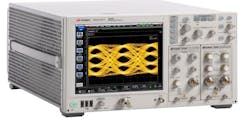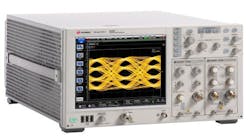Noise may be part of celebrating a New Year, but it is usually not a welcome element in a high-frequency test system. That is, unless it is intentional. Noise of some kind can be found in most RF/microwave systems. One way to better understand its impact on a particular system is by generating known amounts of noise and then sending those noise signals through the system as with a high-frequency signal generator. Different systems have different “noise thresholds” and noise sources provide an effective starting point for measuring the effects of noise on those systems.
Noise results from the random motion of electrical energy, of its electrons and holes, as a result of thermal effects on different materials. Some materials are “noisier” than others and designers of low-noise circuits, for example, will seek out printed-circuit-board (PCB) laminates with stable, low-noise characteristics. In effect, a circuit material can convert thermal energy into noise energy, and this is an undesired effect in most high-frequency communications systems, causing desired signals to compete with noise for reception by a receiver. Noise sources represent a means of injecting a known amount of noise into a receiver to find the noise level at which the receiver can no longer detect a known desired signal level.
Noise exists in various forms, such as phase noise and white noise. Phase noise refers to the random fluctuations in phase at a particular signal carrier frequency while white noise refers to signal energy that is spread across a wide bandwidth from a signal carrier, with amplitude decreasing at frequency further from the carrier, in a Gaussian distribution. White noise can serve as an effective test signal source. It has properties that can be well defined and used for component and system analysis. It is much like a test signal generator, except its power spectral density is spread evenly across frequency rather than just at one frequency as with a test signal generator.
White noise generators are practical test-signal sources for characterizing key performance parameters of RF/microwave receivers, including receiver gain, noise figure, and signal-to-noise ratio (SNR). A simple white noise source usually starts with a noise diode and ends with attenuation and/or amplification to control the output noise power level. As a test tool, it must have a calibrated output noise level or precisely known excess noise ratio (ENR) which can be used when making noise figure calculations based on measured data. A noise source
For more flexibility, programmable noise generators can provide adjustable levels of noise power across variable bandwidths set at tunable center frequencies. Unlike noise sources, which are typically component-sized devices, noise generators are typically full-sized, rack-mount instruments that can be controlled with computer and software in an automatic-test-equipment (ATE) system. A number of manufacturers offer coaxial or waveguide noise sources for simple testing and full-featured noise generators for more elaborate noise-based measurements. Several offer excellent noise source tutorial literature on their web sites, including “Noise by the Numbers” from long-time noise specialist Noisecom and “Fundamentals of RF and Microwave Noise Figure Measurements” from Keysight Technologies.
Noise is a broad topic and this particular blog barely scratches the surface in covering the impact of noise on modern electronic systems. Future blogs will take a closer look at phase noise and its effects on communications systems performance, at how noise analyzers can benefit in noise test systems, and at how different oscillators, synthesizers, and other high-frequency signal sources compare in terms of phase-noise performance. Even at higher frequencies, noise is an attention-getter and should never be ignored.

